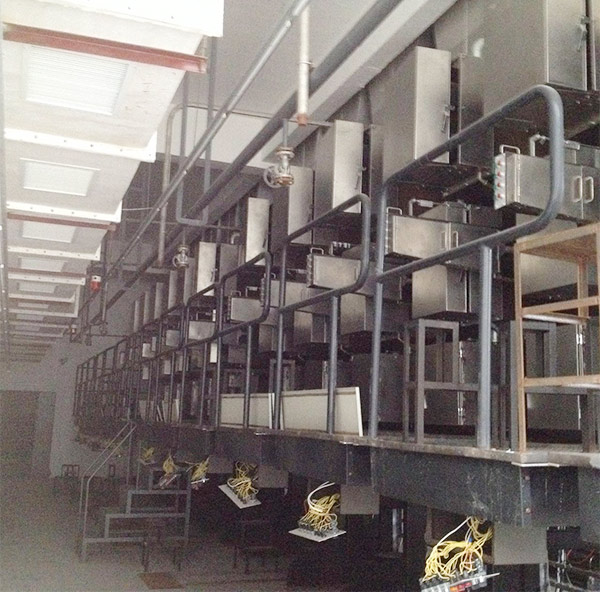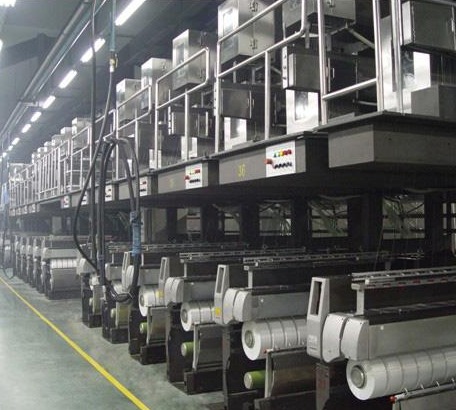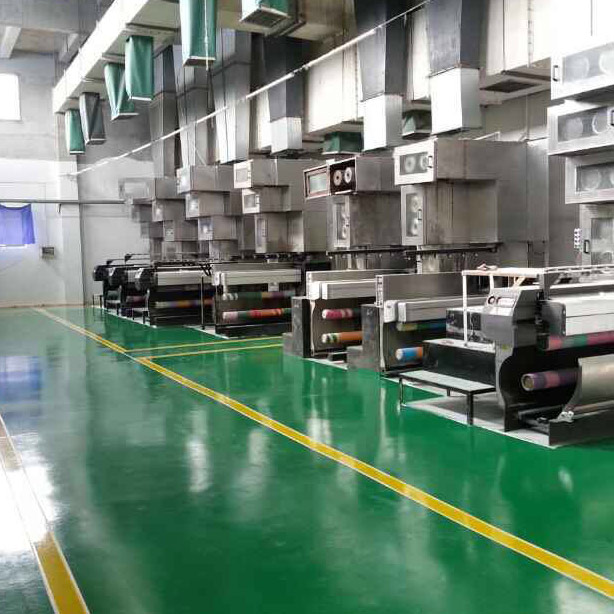- Polypropylene spinning machine
- Polypropylene FDY equipment
- Polyester POY spinning machine
- Polyamide FDY common and high strength equipment
- Polyester FDY equipment
- Polyester high strength equipment
- polyester、Polyamide、 Polypropylene BCF equipment
- Small spinning machine
- All kinds of spinning special parts
- Focus on six core modules to unlock new driving forces for the upgrading of the recycled fiber industry chain
- The China (Shishi) International Textile and Apparel Expo and the National Fashion Textile and Apparel Supply Chain Exhibition kicked off
- Argentina has lifted anti-dumping duties. The Textile Association has taken measures to break the deadlock and help foreign trade enterprises navigate the international market!
- Cotton textile industry fifteen five development guidance seminar was held in Anqing
- Explore the spinning machine: four functional areas, open the secret door of fiber production

- Contact:Mr. Huang Guofu
- Cel:0086-13901505556
- Fax:0086-519-83341119
- Email:czfb5556@126.com
- Add:No. 288-8 ChangLi Rd, Huangli Town, Changzhou, JS PRV.
In the fourth quarter, China's textile and garment exports gradually stabilized, and the proportion of intermediate exports in textile and garment exports continued to rise, providing new momentum for international supply chain cooperation and substantive expansion of exports to traditional markets.
From the perspective of intermediate exports, under the low base effect, the number of yarn fabric exports increased for four consecutive months, and the price decline in the fourth quarter narrowed compared with the third quarter as a whole. Among them, the export of yarn fabrics to ASEAN has rebounded, up 3.7% year-on-year, and has turned positive for the first time since April this year.
2023 national yarn import and export overview
From the policy level, the Central Economic Work Conference emphasized expanding high-level opening up, accelerating the cultivation of new growth drivers for foreign trade, effectively opening up the blockage of foreign nationals coming to China for business and tourism, and focusing on the implementation of the eight actions to support high-quality joint construction of the "Belt and Road". The "going deep and going solid" of relevant policies will continue to promote China's textile and garment exports.
From the perspective of the international environment, the US economic recovery is better than expected, and the continued digestion of buyers' inventories may bring good news for the export of intermediate products such as yarn and fabric in the next stage.
The decline in yarn exports from January to November narrowed from the third quarter
According to customs data, from January to November 2023, the total value of yarn imports and exports was 18.17 billion US dollars, down 3.7% year-on-year. Among them, the export of US $12.71 billion, down 8.5% year-on-year, narrower than the third quarter of 4.8 percentage points; Imports reached US $5.46 billion, up 9.6% year on year.
In November 2023, China's yarn exports were 1.06 billion US dollars, down 4.0% year on year; Exports were 495,000 tons, up 3.3% year on year. China's yarn import value of 530 million US dollars, an increase of 56.5%; Imports were 186,000 tons, up 71% year-on-year. Yarn imports pull textile imports 21.8 percentage points, pull textile and garment imports 10.7 percentage points.
Due to the large price difference between domestic and foreign cotton yarn in the second quarter, the willingness of importers to order continues to rise, resulting in the recent arrival of imported yarn to Hong Kong, pushing up imports. Among them, India and Pakistan's exports of cotton yarn to China in November increased by 760.8% and 278.1%, respectively. According to the feedback of several cotton yarn trading enterprises and weaving factories in Jiangsu, Shandong, Zhejiang and other places, it is expected that from December 2023 to February 2024, Pakistan and India's cotton yarn exports to China are difficult to cool down, and the year-on-year growth rate or continue to rise.
2023 textile machinery export pressure is obvious
According to customs statistics, in the first three quarters of 2023, China exported 3.382 billion US dollars of textile machinery to 195 countries and regions, a year-on-year decrease of 18.67%. From the perspective of export product categories, the seven categories of products all showed different levels of decline.
In the first three quarters of 2023, the export of spinning machinery was about 490 million US dollars, a decrease of 31.7%. The export of spinning equipment, special spare parts and auxiliary devices was about 216 million US dollars, a decrease of 9.38%. The export of ring spinning machine and rotary spinning machine decreased significantly, of which the export amount of ring spinning machine decreased by 62.2% year-on-year, and the export amount of rotary spinning machine decreased by 41.8% year-on-year. Wei Yingguang, deputy secretary-general of the China Textile Machinery Association, believes that this indicates that the demand for new and renovation projects in the main export market of China's spinning equipment has declined significantly. Spinning machinery main export countries for Vietnam, India, Turkey, Pakistan, Bangladesh and so on.
In knitting machinery, the export of circular weft machine has a large decline. In the traditional export key markets, the amount of exports to India and Indonesia increased year-on-year, and the rest, such as Vietnam, Turkey and Bangladesh, declined.
The international market pressure of dyeing and finishing machinery industry has intensified significantly compared with previous years, and the imports and exports of dyeing and finishing machinery in the first three quarters of 2023 showed a declining trend. Southeast Asia is the main export of our dyeing and finishing machinery, printing and dyeing products are mainly exported. Due to sluggish global demand and the impact of foreign exchange tightening and other factors, equipment investment in Southeast Asia and other countries has decreased, and dyeing and finishing machinery exports have declined. However, it is worth noting that in the first half of 2023, China's dyeing and finishing machinery exports to Russia increased significantly.
In terms of nonwovens equipment, according to customs data, the cumulative export of nonwovens machinery in the first three quarters of 2023 was 130 million US dollars, down 46.03% year-on-year, and the top five export places were India, Vietnam, Russia, Japan and Turkey.
What is the impact of the UK carbon tariff on the textile industry?
Since the EU, the UK has also announced the implementation of "carbon tariffs"! On December 18, local time, the British government officially announced that it will implement the UK Carbon Border Adjustment mechanism from 2027.
It is worth noting that although the textile industry is not currently included in the carbon market, it does not mean that the textile industry does not need to reduce carbon emissions. In March 2022, the European Commission officially issued the EU Strategy for Sustainable and Circular Textiles (EU Strategy for Sustainable and Circular Textiles) and the Sustainable Product Eco-Design Regulation. It describes three key initiatives that the EU will take to promote the sustainable development of the textile industry: the introduction of mandatory ecodesign requirements, tackling microplastic pollution and the introduction and regulation of digital product labelling. The application requirements for bio-based materials, recycled materials in the value chain, digital product passports and mandatory extended producer responsibility schemes are also highlighted. These international policies, as the future trend of the textile industry, have brought new challenges to the export trade, and domestic textile enterprises need to consider the layout in advance.
Since the 1990s, with the deepening of the global understanding of sustainable development, the society has gradually increased the disclosure requirements of enterprises in CSR (corporate Social responsibility) and ESG (environmental, social and governance), and the indicators of energy consumption, waste management, pollution control and social management of enterprises have also become important factors for investors to consider.
The social responsibility system of textile production enterprises requires production enterprises to be responsible for the whole life cycle of their products, and this system urges production enterprises to consciously choose materials and formulate recycling work plans to avoid producers becoming "bystanders" in the cause of environmental protection. China has also launched the "textile and garment Corporate Social responsibility Management System" (CSC9000T), from the pollution, resources, climate change three aspects of the emphasis on the environmental responsibility of textile enterprises, pointing out that to minimize the negative impact of enterprises on the environment as the goal, require to reduce pollution, save resources, reduce greenhouse gas emissions, adapt to climate change, Ensure the sustainable development of enterprises and environmental ecology.
Declaration: The content of this article are organized from the network, and the copyright belongs to the original author. If there is infringement, please inform in time and contact to delete.
Changzhou Fubon Chemical Fiber Machinery Factory Technical production: Polypropylene spinning machine, polypropylene FDY spinning machine, polypropylene FDY equipment, polyester POY spinning machine, polyester POY production line, polyester POY equipment, polyester POY machinery, polyester recycled bottle FDY spinning machine, polyester FDY spinning machine, polyester FDY machinery, Spandex spinning machine, spinning special parts, polyester small Experimental machine, polypropylene small experimental machine, nylon small experimental machine.
- The China (Shishi) International Textile and Apparel Expo and the National Fashion Textile
- Focus on six core modules to unlock new driving forces for the upgrading of the recycled f
- Argentina has lifted anti-dumping duties. The Textile Association has taken measures to br
- Cotton textile industry fifteen five development guidance seminar was held in Anqing
- Explore the spinning machine: four functional areas, open the secret door of fiber product
- Manager must read | say goodbye to control management, release the potential of employees,
- Empower the traditional garment industry with digital technology
- Fubon Chemical fiber Polyester industrial silk spinning and drawing machine equipment: the
- Textile information | Industry empowerment, when calligraphy meets fabric, Keqiao textile'
- High performance carbon fiber and composite material technology and equipment seminar was




